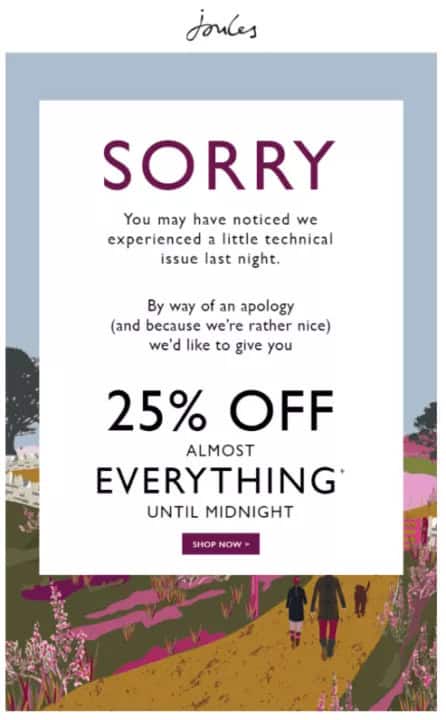“Sorry for the inconvenience.”
Those four little words are never fun to receive in an email, live chat, or other professional communication.
However, they’re not that much easier to send. After all, no business wants to admit that they’ve made a mistake. It doesn’t feel good, as there are all sorts of worries associated with it. What if your customers think you’re unprofessional? What if they decide to take their business elsewhere?
Well, what if I told you that there’s a way to handle these communications while still maintaining trust and loyalty delicately? Customer-centric apologies might never get easier to send, but if it has to be done, then so be it.
From delays to service outages, emails sent to the wrong address, and other gaffes, learn the fine art of sending “sorry for the inconvenience” messages to keep your customer relationships strong.
Table of Contents
Key Takeaways
- A sincere apology is necessary, but it should be combined with a solution when writing “sorry for the inconvenience” correspondence. This way, you can maintain customer loyalty.
- Stop overusing phrases like ‘Sorry for the inconvenience,’ they come across as robotic; instead, say things that make your customer feel that you understand their frustration and show your commitment towards resolving the issues.
- Use EngageBay’s tools to improve customer communications.
Why Apologies Matter in Customer Service
Mistakes happen, even to the best of us; how you handle them matters. Will you take the thoughtful, empathetic approach, or will you try to sweep it under the rug?
Apologizing might not be easy, but it’s always the correct answer.
According to Psychology Today, apologizing puts us in the other person’s shoes, which makes them more likely to forgive us. More so, sincere apologies help people move forward, get over their anger, and begin their emotional healing after a transgression.
In other words, apologies have some major psychological power.
And that’s not all. They’re also excellent at improving customer retention. Data has found that apologizing clearly and straightforwardly can boost customer retention by over 15 percent. I don’t know about you, but that sounds great.
As much as the verbiage of your apology is necessary, so is the timing. You have to be ready to issue your “sorry for the inconvenience” message shortly after identifying the issue.
Customers will appreciate that you recognize your delay or mistake has caused hardship in their lives.
Apologizing might not make it all better immediately, but it does buy you time until you can amend the issue. In that regard, an apology is worth its weight in gold.
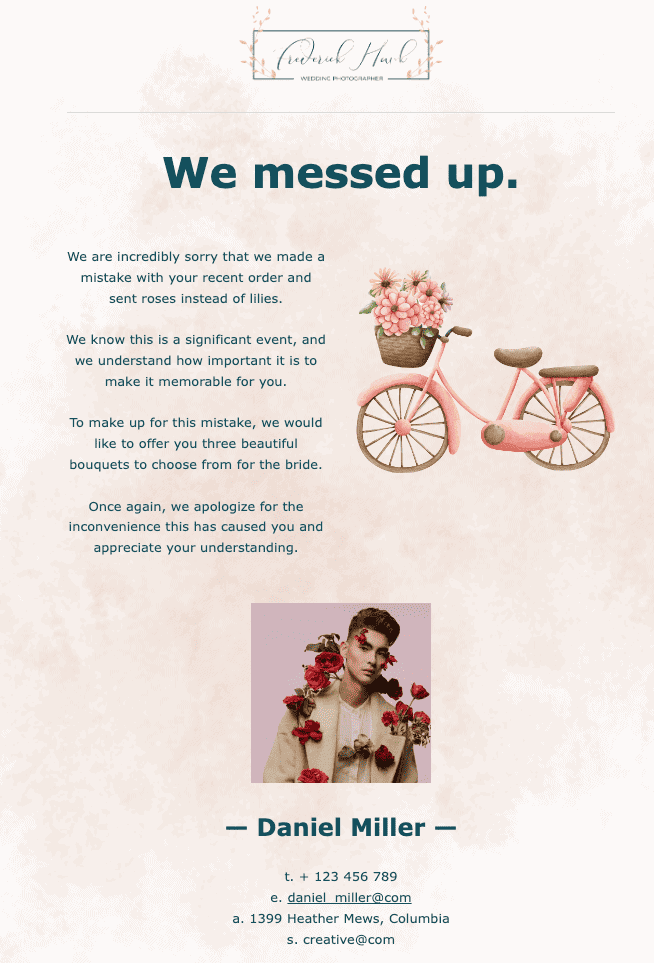
Common Situations Where “Sorry for the Inconvenience” Is Used
All sorts of scenarios will arise throughout your business’s lifespan that warrant an apology or two. Here are a few that you should have on your radar.
Service interruptions
Whether it’s the power to your house, your office internet, or your billing software, when things go kaput when they’re not supposed to, it’s frustrating. We’ve all been there, and tensions can run high.
Customers are annoyed because they have things they need to do or reasonable expectations of the service they’re supposed to receive.
Utility, software, and internet outages will happen, so you need to be ready to handle them with aplomb. Don’t ignore the issue or pretend it isn’t happening. Instead, as soon as the reports begin coming in about a problem, issue a swift apology.
Sure, an apology doesn’t turn the power back on or make the internet work again. Your customers know that.
It’s all about reducing those bad feelings and showing that you care.
Product delays
Have you ever ordered something excitedly, only to find out later that it’s been delayed? Or perhaps you order something and never hear back about it, even after months pass.
These kinds of situations can get aggravating fast. While customers’ money is in limbo, they appreciate regular updates about their orders. Besides that, peppering in a few sincere apologies can tamp down bad feelings.
Stock issues
Another problem that can cause acrimony among your audience is stockouts. Sometimes, you might not anticipate that a product will sell as well as it does, and you run out of stock faster than anticipated.
Customers can find it unfair if they don’t get to order what they want because the item was out of stock in two minutes flat.
When saying “sorry for the inconvenience” in this context, you should also estimate when the product might be available to order again.
Billing errors
Okay, a billing error is a big mistake, but guess what? It happens. Human error affects us all. Don’t beat yourself up too much about the gaffe. Instead, focus on smoothing things by issuing a sincere, timely apology.
Customer service mistakes
A well-trained customer service team can handle all kinds of customer issues. They’re also experts at calming down irate customers. Even still, sometimes, a rep doesn’t handle a customer complaint or question with as much gentleness as it may require.
When that happens, you need to be ready to jump in and apologize. That can pave the way for more future positive interactions between your company and the customer.
Case study: Example of a company using this phrase in the proper context
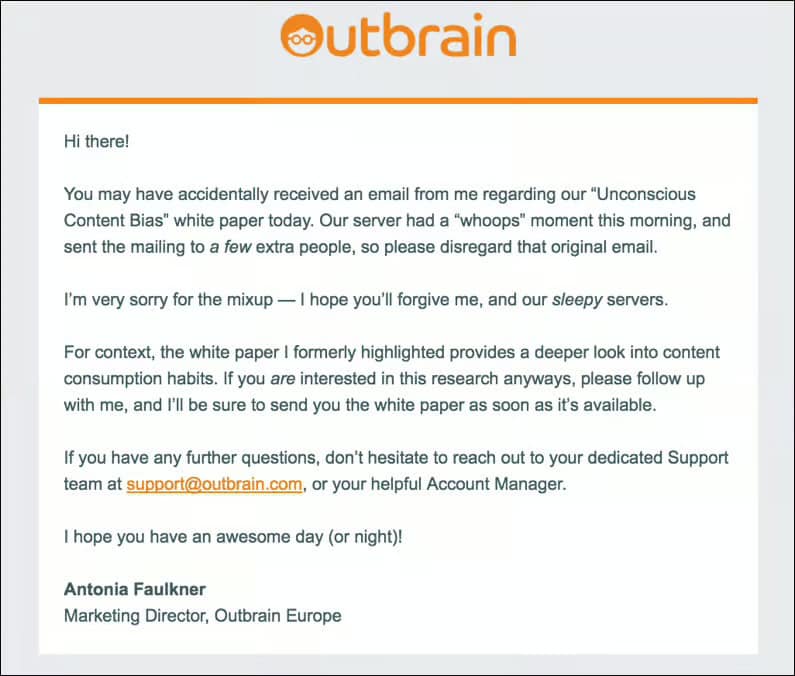
Here’s an example from business resource Outbrain that proves that mistakes happen to us all.
Their message was about an email sent to subscribers who weren’t supposed to receive it, which contained a whitepaper.
Outbrain mentions it was a server issue, using such terms as its server having a “whoops” and being “sleepy.”
The tone of the copy is friendly and straightforward. Outbrain mentions the mistake and then asks for forgiveness. Smartly, they provided context on the whitepaper after that so that those who didn’t have access to it but are curious can request the resource.
Finally, they included their support contact information so those who had questions or wanted to follow up could do so.
Enhance Your Email Marketing
Show your sincerity and rebuild trust with our beautifully crafted, easy-to-customize apology email templates! Simply personalize your brand’s images, empathetic headings, and CTAs, and send thoughtful, professional apologies in minutes!
The Right Way to Apologize to Customers
As with many things in life, apologizing is all about what you say and how you say it.
While you could outright use “sorry for the inconvenience” as your go-to, most apologies require more nuance than that. Let’s look at some apology pointers to bear in mind.
Stay positive
Although saying you’re sorry means dealing with something inherently negative, how you frame it is everything. You should maintain an upbeat attitude that keeps the error in a severe light.
You want to admit what you did but then understand how you will make it right. You can ask for forgiveness, like in the Outbrain example, but you should never grovel.
Offer a resolution
You could refund the customer for their shipping costs if an order is delayed or prioritize expedited service. You could refund them for an item that never came or give them a discount on their next purchase.
Yes, sometimes you have to lose a bit of money when mistakes happen, but that’s just the nature of it. What matters more is making things right with your customers.
Don’t overuse it
I’m sure you’ve heard the story of the boy who cried wolf, right? After a while, people didn’t listen to his pleas, even when a wolf did show up.
Apologies are the same way. They matter the first time a customer hears them, but if you have to say “sorry for the inconvenience” 10 times a year, it comes across as nothing more than inanity after a while.
Besides reducing your rate of errors, you should also look at which situations warrant an alternative solution. For example, you jump right to the refund.
Be prompt
Time is of the essence when sending an apology. You can’t automate these messages because you never know when you will have to send them. Someone might have to come into the office on their off day or work late to get the apology issued, but hopefully, it won’t have to happen again.
Take responsibility for the error
An apology only matters if it feels authentic, and you can only be authentic if you’re willing to admit what you did wrong. Be clear about what part you played in the issue, whether it was underestimating your supply of stock or not double-checking your recipients list before you sent your last email.
Customers will appreciate that you own up to your mistakes. That, combined with the apology, should help you save face.
Mention how you’ll be more proactive
Your audience also appreciates hearing how you intend to prevent the issue from occurring again. What steps can you take to reduce instances of mistakes?
Maybe you use inventory management software to prevent stockouts or update your server so your website doesn’t crash when people try to shop.
Here’s a little example for you of how to apologize effectively.
Take a look at this Zocdoc email. If you’re unaware, Zocdoc is a medical service that schedules appointments. Zocdoc sent this email to apologize to its client, whose appointment was canceled through their service.
Zocdoc offered to send an Amazon gift card to make up for it. That sounds like a pretty sweet way to make it up.
I also like how they included this statement: “This sort of thing is very rare. I want to make it right if there was any trouble here!”
Apologizing Via Email: Templates for Common Scenarios
Sincerity and good timing are essential when sending a “sorry for the inconvenience” message to your email audience.
Although these messages should go out quickly, you should always check that the wording uses your brand tone. Also, your email should be free of typos and other mistakes that would reflect even more poorly on you.
The following apology email templates will help you nail the right messaging to ensure you take responsibility and produce a viable solution.
Apology for delayed shipping template
Sometimes, shipping delays are out of your hands. Maybe part of your supply chain got backed up, or perhaps you work with a dropshipper, and they’re experiencing delays.
Regardless of the reason, this kind of template will help you make it up to your customers:
Subject: Oops! Your Order Is Running Late
Hey [Customer’s Name],
We’re sorry to let you know that your order [Order Number] is running a bit behind schedule. We know how frustrating that can be, and we’re doing everything we can to get it to you as quickly as possible.
Your new expected delivery date is [new delivery date], and we’ll keep you posted if anything changes along the way.
To make up for the delay, we’d love to offer you [a discount, free shipping, or another incentive] on your next order—just a small way to say thanks for your patience.
If you have any questions, feel free to reach out to us at [customer service email/phone number]. We really appreciate your understanding!
Best,
[Company Name]
Apology for service outages or interruptions template
Service interruptions and outages, while unacceptable to some of your customers, do happen. If yours are rare instances, then most of your customer base should be willing to forgive and forget. Sending unhappy customers an email like the one below will also help:
Subject: Sorry for the Service Disruption
Hi [Customer’s Name],
We wanted to give you a quick heads-up and apologize for the recent service outage. We know how much this kind of thing can throw off your day, and we’re really sorry it happened.
The good news is that everything should be back online now! If you’re still experiencing any issues, just drop us a line—we’ve got your back and will get things sorted out ASAP.
To say thanks for your understanding, we’d like to offer you [a discount, credit, or another incentive]. We appreciate you sticking with us and are working hard to make sure this doesn’t happen again.
If there’s anything else we can do, please reach out at [customer service email/phone number].
Thanks again,
[Company Name]
Apologies for miscommunication or misunderstanding
No one is perfect, so misunderstandings and miscommunications will happen. Being proactive and apology-oriented now will prevent bad feelings from simmering and boiling over later. Here’s what to say:
Subject: Let’s Clear Things Up—Our Apologies!
Hi [Customer’s Name],
We wanted to reach out and apologize for any confusion caused by our recent communication. It looks like there was a mix-up on our end, and we totally understand if it left you feeling frustrated.
We’re here to make things right. Here’s what happened: [briefly explain the miscommunication]. And here’s how we’re fixing it: [explain the solution or next steps].
Thanks for your patience as we get this sorted out. We really appreciate your understanding and want to make sure everything is crystal clear moving forward. If you have any questions or need further clarification, please don’t hesitate to reach out—we’re happy to help.
Looking forward to getting back on the same page!
Best,
[Company Name]
Read more: How and When to Say ‘My Sincerest Apologies’
Using “Sorry for the Inconvenience” in Customer Service Scripts
Now that you’re getting more familiar with the idea of apologizing to your customers, it’s time to train the rest of your staff on the same. Focus on customer service and sales teams as well as anyone who directly interacts with customers.
How do you get everyone on the same page? Here are a few pointers and customer service apology examples to incorporate into your training.
Teach the basics of empathy
Empathy and sympathy are not the same. When you feel sympathetic, you feel bad for a person, but when you’re empathetic, you can imagine yourself in their shoes and more personally relate. You might still feel sadness or anger for their disappointment or frustration.
The problem with sympathy in some scenarios is that it can come across as manufactured and inauthentic. If your customers believe that a customer service rep is being snarky with them, they might get even angrier.
Worse still, you could lose them as customers.
Being empathetic means:
- Truly listening to what the other person says.
- Limiting the insertion of your opinions into the discussion.
- Allowing the other person to explain how they feel rather than assuming you already know.
- Relating to the other person if you can do so and not forcing it if you cannot.
Prioritize action-oriented responses
Just like when you send an email to your customers saying, “sorry for the inconvenience,” a phone call where you address a customer complaint requires the same sort of forward-thinking approach.
In other words, once you hear about their problem, you need to start thinking on your feet about how to fix it. This isn’t something you can so much teach your team, although modeling it will certainly help.
You should also review transcripts of sales and customer service calls to determine who’s taking the most action-oriented approaches. It might be good to provide further instruction to those who aren’t.
Put together customer service scripts
If your customer service team has never handled situations of this magnitude before, it’s not a bad idea to assemble a few customer service scripts they can rely on for their first few apology-oriented phone calls.
However, be advised that using scripts can come across as too rehearsed and robotic. Your customers, who are already upset, might feel like your reps are being condescending or don’t care enough.
By all means, start with a script, but your reps should wean their way off them quickly.
Use helpdesk and live chat tools
Managing customer calls and complaints can be a precarious juggling act, but it has to be done. That is why customer support software and CRM software are essential.
These tools help you route your customer support tickets, chat live with customers, make and receive calls (with some integrations), assign customer service tasks to agents with customized permission settings, and more.
EngageBay also offers a free helpdesk and live chat widget, so give them a try and ease your headaches 🙂
Read more: 8 Customer Support Email Templates to Make Customers Happy
Alternatives to “Sorry for the Inconvenience”
An apology is an apology, no matter how you say it, right? Well, yes and no.
Even using the term “sorry for the inconvenience” can come across as too formal and stuffy for some. So, what should you say that’s in the same vein but feels more human and empathetic?
Here are some alternatives I prefer:
- “We understand your frustration.”
- “We appreciate your patience.”
- “We know this has caused some disruption, but we’re working to make it right.”
- “We realize this isn’t ideal.”
- “We’re grateful for your understanding.”
- “Thanks for bearing with us.”
- “We’re sorry for the trouble.”
- “We know this isn’t what you expected.”
- “We understand this must be a disappointing setback.”
- “We truly appreciate your flexibility.”
So, why these alternatives? Well, for a few reasons.
For starters, the above messages don’t sound generic, which is a fault that “sorry for the inconvenience” undoubtedly has. Further, these alternatives soften the message, which your audience might be more receptive to.
Just look at these two examples to see what a difference it can make.
1. Toronto Maple Leafs apology email
First, there’s this apology from the Toronto Maple Leafs about a poor season:
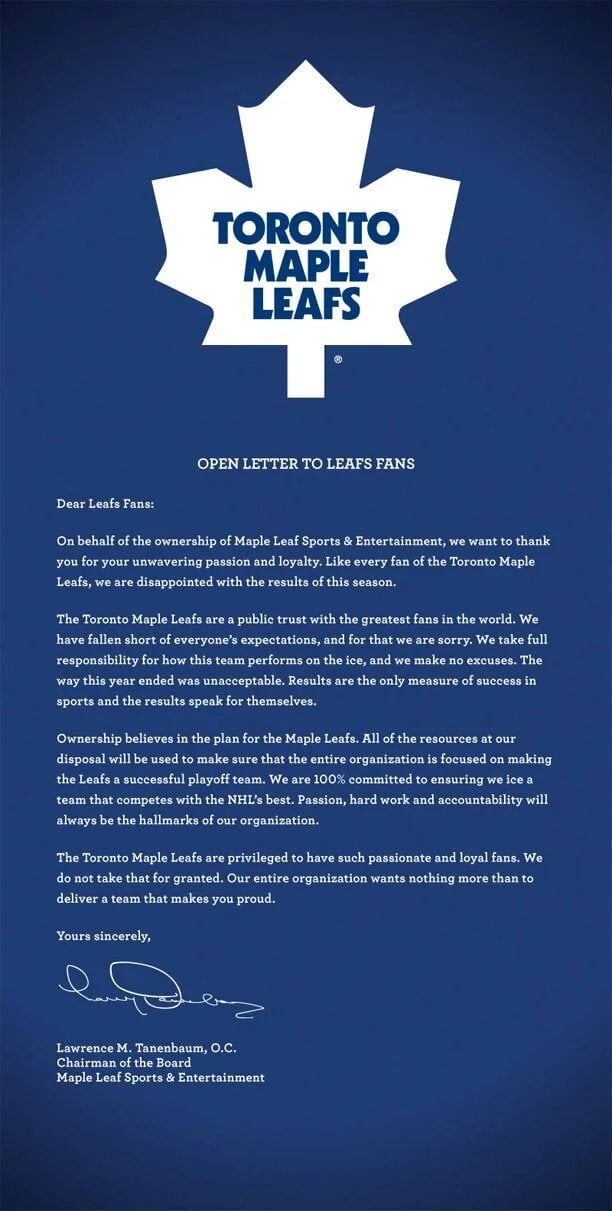
It’s very formal and even a little stuffy, especially for a sports team, which is all about high-octane action.
2. Fab’s purrfect apology email
Now, let’s compare that apology to this one:
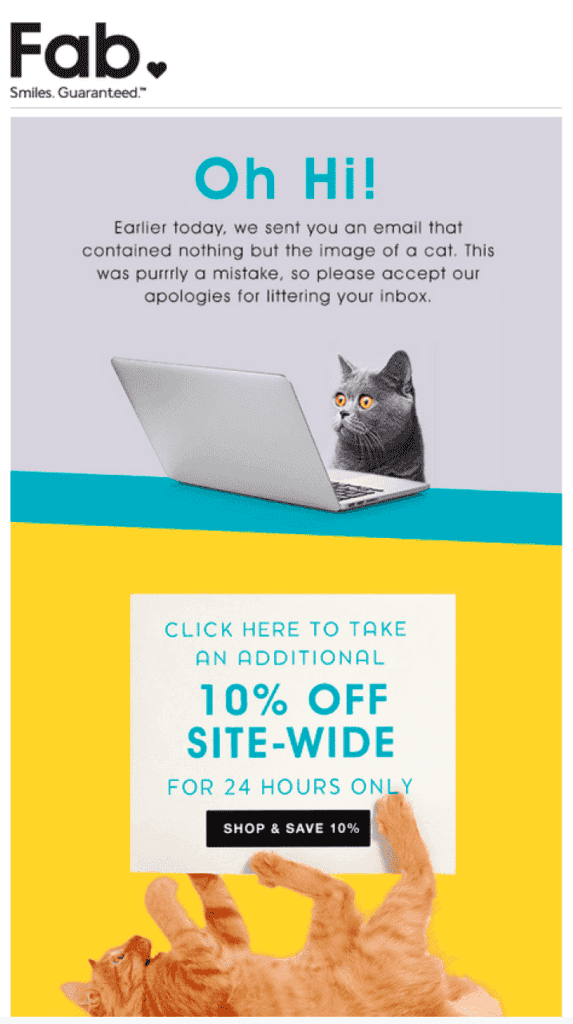
This email from Fab couldn’t be any shorter and more informal.
Of course, there’s a tone and a place for everything (see what I did there), so it’s not necessarily that the Maple Leafs email is the wrong approach to take.
Softer apologies just land better.
3. Joules’ apology for a technical issue on their site
Apart from being straight to the point, Joules throws in a sweet 25% discount to smooth over any bumps caused by the hiccup. This makes up for the hassle and gives folks a good reason to dive back into shopping. Pretty clever, right?
Handling Negative Feedback After Apologizing
By this point, you’re a pro at knowing how to say sorry professionally and when. However, are you ready for what happens if apologizing doesn’t sate the customer’s anger?
Yes, that’s right. Sometimes, telling a customer “sorry for the inconvenience” doesn’t get the job done.
Hopefully, the customer will receive constructive criticism. You know, the kind that helps your business improve because you get pointers on what you could be doing better. Then, it’s up to you to implement that information into how you operate your business.
And even if you do, your work isn’t entirely done there. You and your staff must learn to apologize in a way that’s not condescending, formal, stuffy, or insincere. This will look a little different for everyone depending on your brand identity.
Also, remember that an apology only goes so far. Be willing to put your money where your mouth is and remediate the issue by offering free shipping, a refund, a discount on their next order, or whatever will help you make it up to the customer.
Case study
And yes, it is possible to recover and keep moving forward even after a big mistake. For proof of that, look no further than Airbnb.
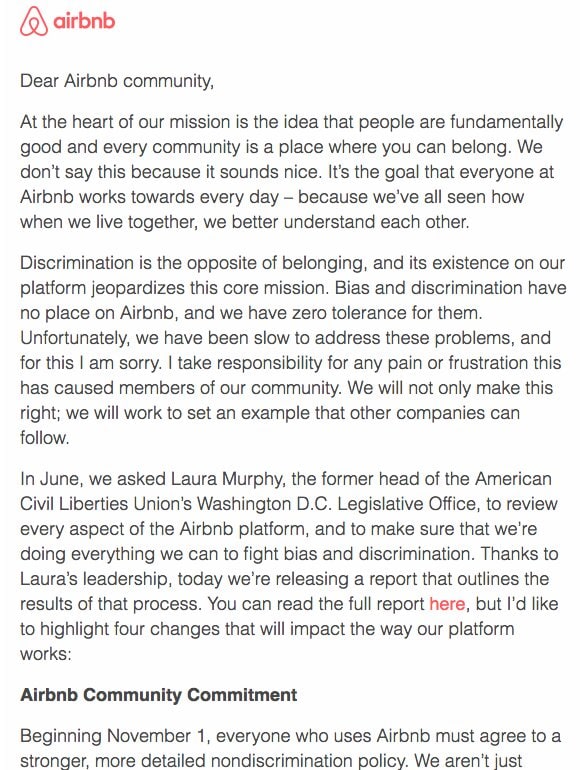
The recreational lodging giant discovered instances of discrimination on its platform, something it took very seriously.
They admitted that they could have been faster in addressing the biases that had been running rampant. Then they took action.
The Airbnb team requested that the once-head of the American Civil Liberties Union’s Washington D.C. Legislative Office, Laura Murphy, review the entire foundation of Airbnb to ensure it’s operating without discrimination.
Airbnb published the results of that report to further improve transparency and then provided a TL; DR version in its email.
Discrimination and bias are heavy accusations, and Airbnb went above and beyond to improve its platform and make it more inclusive.
Apology Etiquette: Do’s and Don’ts
Keeping your customers happy doesn’t have to be complicated. Remember these do’s and don’ts for those times when you have to say “sorry for the inconvenience,” so your apology will mend fences effectively.
DO acknowledge the problem
You can’t fix a problem until you admit there is one.
It’s hard to downplay some issues, like citywide power outages. But either way, your goal isn’t to pretend the issue isn’t happening. It’s to get the problem fixed and improve your customer relationships.
Be upfront about the problem in your initial correspondence to the customer.
DON’T forget to offer a solution
Customers don’t just want apologies. They amount to mere platitudes. They want a resolution.
You can’t always offer that immediately, such as if their order is lost in transit. The next best thing is giving them something to sweeten the pot, from a discount to a freebie or an exclusive free shipping offer.
DO take responsibility
Listen, barring severe weather or another act of God, you have to fess up that you’re the one who did the wrong thing.
Your customers want you to take responsibility. It’s part of the transparency process that today’s consumers value so much. It’s not about assigning blame or pointing fingers. It’s about doing the correct thing.
Sure, you can say that weather or another outside factor contributed, but don’t use any scapegoats.
DON’T blame the customer
Even if the customer is somehow at fault (or partially at fault), you shouldn’t blame them for the mistake. That’s especially the case if they had no bearing on the current issue.
Pointing the finger at the customer to try to get the blame off yourself will always backfire. You will more than likely lose that customer for good. They’ll also post some nasty remarks about you on social media, which can cause you to lose other customers as well.
DO be crystal-clear in how you’ll make it right
Vague responses can’t be part of your “sorry for the inconvenience” correspondence. You need to be clear that a mistake happened, take responsibility, and offer to fix it.
DON’T skip a follow-up
Okay, so you sent the email, and the customer decided a coupon code was good enough until you could fix their issue. Case closed, right?
Not exactly. You should send at least one follow-up email updating them on where you are on a resolution. If you still don’t have a resolution at that time, then send another follow-up when you do.
DO send feedback surveys and improve
Mistakes happen, but you should always think of ways your business can transcend common issues. Feedback surveys are one way you can double down on your strengths and reduce your weaknesses, as you can implement advice directly from your customers.
DON’T use apologies too often
Do you want to make a lasting positive impact after apologizing to your customers? Then don’t wear out your apology’s welcome.
Remember, it’s like the boy who cried wolf. If you apologize too often, it loses all meaning. The best apologies are issued incredibly rarely.
Read more: The Ultimate Apology Email Checklist
Conclusion
How to say sorry professionally is as easy as stating “sorry for the inconvenience,” right? Yet it’s a lot deeper than that. You have to choose the right tone, wording, and timing for communications. You must also be solution-oriented to make things right.
Businesses must be proactive in customer communication and be honest, owning up to their mistakes to improve customer relationships.
FAQs
How long should I wait before following up on an apology?
Give it at least several business days, maybe up to a week, depending on what the issue is and how pressing it is.
Should businesses apologize publicly or privately?
Keeping the apology private—meaning only communicating with those affected—is usually the smarter move. For one, it loops in only those people affected. Secondly, you avoid making a public spectacle of your business and affecting your reputation.
What are some common mistakes to avoid when issuing a public apology?
If you must apologize publicly, make sure you don’t:
- Minimize the problem.
- Blame anyone else.
- Disregard how inconvenient/upsetting the issue is for your customers.
- Use vague language.
- Offer no resolution.

